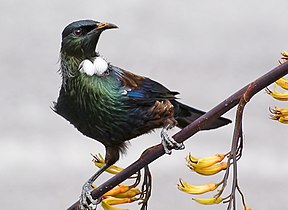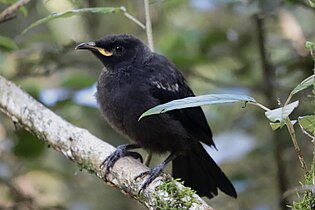Tuihonigfresser
| Tuihonigfresser | ||||||||||||
|---|---|---|---|---|---|---|---|---|---|---|---|---|
 Tuihonigfresser(Prosthemadera novaeseelandiae) | ||||||||||||
| Systematik | ||||||||||||
| ||||||||||||
| Wissenschaftlicher Name der Gattung | ||||||||||||
| Prosthemadera | ||||||||||||
| G. R. Gray, 1840 | ||||||||||||
| Wissenschaftlicher Name der Art | ||||||||||||
| Prosthemadera novaeseelandiae | ||||||||||||
| (Gmelin, 1788) |
Der Tuihonigfresser (Prosthemadera novaeseelandiae, in Māori tūī) oder Tui ist eine neuseeländische Vogelart aus der Familie der Honigfresser.
Verbreitung
Er ist ein weitverbreiteter Vogel in Neuseeland und ist dort endemisch.
Beschreibung
Er hat ein dunkles, schwarz wirkendes Federkleid. Im Sonnenlicht schimmert dieses jedoch teilweise grünlich und bläulich. Das auffälligste Merkmal ist ein weißes, hervorstehendes Federbüschel am Hals.
Lautäußerung
Die Stimme des Tuihonigfressers ist recht laut und kraftvoll, der melodische Klang wird oft von abwechslungsreichen klickenden und schnarrenden Geräuschen unterbrochen. Er ist dem der südamerikanischen Glockenvögel (Procnias) zum Verwechseln ähnlich, die Stimme der Glockenvögel weist jedoch deutlich weniger Resonanz auf.
Der Tuihonigfresser ist in der Lage andere Stimmen zu imitieren. Die Māori haben sich Vögel gehalten und ihnen das Imitieren menschlicher Sprache beigebracht.[1]
Ernährung
Der Tuihonigfresser ernährt sich hauptsächlich von Nektar, aber auch von Früchten und Insekten. Zeitweilig zählen zu seiner Nahrung auch Pollen und Samen bestimmter Pflanzen.
Besonderheit
2005 wurde in Neuseeland erstmals der Vogel des Jahres gewählt. Der Tuihonigfresser wurde hierbei zum ersten Vogel des Jahres ernannt.
Als ein typisch neuseeländischer Vogel ist er auch Markenzeichen einer neuseeländischen Biermarke (Tui).
Namensherkunft
Der Name Tui wurde der Maori-Sprache entliehen.[2]
Galerie
- Tūī
Tuihonigfresser ernährt sich von Neuseeländer Flachs
Tuihonigfresser auf kōwhai
Juveniler Tūī
- (c) I, Tony Wills, CC BY-SA 3.0
Tuihonigfresser ernährt sich von einer Fackellilie
Tuihonigfresser unter kōwhai
- (c) I, Tony Wills, CC BY-SA 3.0
Federn aufplusternd und rufend
Tuihonigfresser verteidigt eine Nahrungsquelle vor einem viel größeren Kaka-Papagei
Weblinks
- Prosthemadera novaeseelandiae in der Roten Liste gefährdeter Arten der IUCN 2008. Eingestellt von: BirdLife International, 2008. Abgerufen am 31. Januar 2009.
- Tuihonigfresser (Prosthemadera novaeseelandiae) auf eBird.org
Einzelnachweise
- ↑ Christina Troup: Small forest birds – Honeyeaters – bellbirds and tūī. In: Te Ara - the Encyclopedia of New Zealand. Ministry for Culture & Heritage, 3. Februar 2015, abgerufen am 27. Dezember 2015 (englisch).
- ↑ www.dynamo6.com: tūī - Te Aka Māori Dictionary. Abgerufen am 10. August 2022 (englisch).
Auf dieser Seite verwendete Medien
Autor/Urheber: Rosa Stewart, Lizenz: CC BY-SA 4.0
A Tui playing peek-a-boo through the flowers of a Kowhai Tree. The yellow pollen a tell tale sign that he has been feasting on them!
Autor/Urheber: Rosa Stewart, Lizenz: CC BY-SA 4.0
This juvenile Tui was spotted in Cameron Creek Walk in Mount Aspiring National Park in New Zealand's South Island
Autor/Urheber: Marshelec, Lizenz: CC BY-SA 4.0
New Zealand Tui (Prosthemadera novaeseelandiae) singing at Trelissick Park, Wadestown, Wellington, New Zealand. Recorded on my smartphone as a video and exported as OGG file via Audacity
Autor/Urheber: Sid Mosdell from New Zealand, Lizenz: CC BY 2.0
Tui, one of New Zealand's native honeyeaters, are important pollinators of native forest flowers. The tui's beak is perfectly shaped to fit into the harakeke, or NZ flax, flower from which it feeds on nectar.
They are intelligent, aggressively territorial, and are said to be able to imitate the calls of nearly every other bird, as well as a vast array of other sounds.Autor/Urheber: Tony Wills, Lizenz: CC BY-SA 3.0
At a supplementary feeder setup to encourage Kaka parrots (Nestor meridionalis) to nest within the Zealandia wildlife sanctuary, a tui (Prosthemadera novaeseelandiae) decides the food source (a liquid supplementary food called "Wombaroo") is worth commandeering. Zealandia, Wellington, New Zealand.
Autor/Urheber: Bernard Spragg. NZ from Christchurch, New Zealand, Lizenz: CC0
The tui (Māori: tūī; Prosthemadera novaeseelandiae) is an endemic passerine bird of New Zealand, and the only species in the genus Prosthemadera. It is one of the largest species in the diverse Australasian honeyeater family, and one of two living species of that family found in New Zealand, the other being the related New Zealand bellbird. The species has a wide distribution in the archipelago, ranging from the subtropical Kermadec Islands to the sub-Antarctic Auckland Islands, as well as the main islands
(c) I, Tony Wills, CC BY-SA 3.0
Tui on flax bush with feathers ruffled up, singing to the world (yellow colour on top of beak is pollen from the flax flowers). Wrights hill, Wellington, New Zealand
Autor/Urheber: Marshelec, Lizenz: CC BY-SA 4.0
Tui song - recorded at Johnsonville, Wellington on video using smartphone, then audio converted to ogg format using Audacity
(c) I, Tony Wills, CC BY-SA 3.0
.Tui hanging upside down, feeding on nectar from red hot poker flowers. Wellington, New Zealand.













